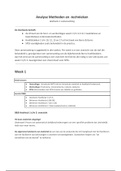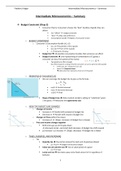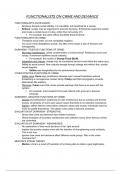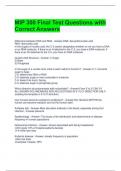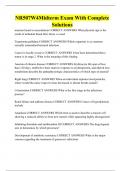Whole summary
Part 1
Lecture recap RBMS
The process of null hypothesis testing
- You can’t prove a negative!
o Instead: Prove a positive by rejecting a negative
example Do pink unicorns exist?
- Formulate a null hypothesis: ‘Pink Unicorns don’t exist’
- Data collection: Someone observes a pink unicorn
o Reject the null hypothesis: ‘Pink Unicorns exist’: they probably do
- Data collection: After 100s of years of observation, no one has ever reported to have seen a
pink unicorn
o Retain the null hypothesis: Hypothesis that ‘Pink Unicorns don’t exist’ remains
o Prob of they don’t exist very high, but can never sample whole pop: so hypothesis
remains
- NOT: ‘Null hypothesis is true.’ Does not mean that pink unicorns don’t exist
Research question
A well-formulated research question describes:
- Population
- Intervention
- Comparison
- Outcome variables
- Study design
Hypotheses
- Two-sided hypotheses
o In general:
Null hypothesis: H0: ‘no effect’
Alternative hypothesis: H1 or Ha: ‘an effect’ (can go in either direction)
- One-sided hypotheses
o If two-sided hypotheses are (biologically) implausible or of no interest at all:
Null hypothesis: H0: ‘smaller than’ ‘larger than’
Alternative hypothesis: H1 or Ha: ‘larger than or equal to’ ‘smaller than or
equal to
,Research design
- Research question
o Causal effect or association?
- Dependent variable(s)
o Measurement
- Type (nominal, ordinal, discrete, continuous)
o How many?
o Independent variable(s)
- Measurement
o Type (nominal, ordinal, discrete, continuous)
o How many?
- Manipulation
o Compare groups or conditions? How many?
o Are measurements paired or not paired
- Observational: observation without randomized and manipulation: allows conclusions on
association no causation
o Cross-sectional : all measurements happen at the same time
o Case control: measure outcome look back in time for predictors
o Prospective: follow sample over time for a period
- Experimental: randomization and manipulation, random: allows causation
o Random: participants are randomly assigned to groups, only in one condition
o Cross over: randomly assigned to an order of conditions
Descriptive statistics
- Goal: to present, organize and summarize data observed in the sample
- Measures of central tendency
o Mean
o Median
o Mode
- Measures of dispersion/variability
o range, interquartile range
o variance, standard deviation
- GRAPHS and FIGURES
Inferential statistics
- Statistical test
o p-value = Probability of the data given that the null hypothesis is true
Very unlikely: reject null hypothesis, accept alternative hypothesis
Threshold: α: 0.05 p-value < 0.05 is regarded as ‘unlikely enough’ to reject H0
,t-tests
- One-sample t-test:
o Null hypothesis: 𝜇0 = value
x−μ0
o t=
se
𝑠𝑒 = 𝑠d/√ n precision of the point estimate observation has uncertainties
μ0 = value under the null hypothesis
- Independent samples t-test:
o Null hypothesis: means from two groups are equal: μ0= μ0
o t =( X 1−X 2 ) ¿ ¿
se pooled =
μ 0
−¿ ¿
+¿−μ0 ¿
=
√ sd 21 sd 22
+
n 1 n2
0 under the null hypothesis
- Dependent samples t-test:
o Null hypothesis: means from two conditions in one sample are equal: μ A 0=μB 0
x d−μ D 0
o t=
se D
se D = sd D / √ n
μ D 0= 0 under the null hypothesis
From a statistical test to a p-value
Using probability distributions
- Probability Density
o Probability from 0,
o Sum of surface area is 1
o Probability is a particular area
- Discrete probability distribution
o Probability is always between 0 en 1
o Sum of probabilities is 1
o Probability is a specific value
Empirical vs. Theoretical probability distribution
- Empirical: sample distribution based on the empirical data in the sample
- theoretical: predicted / approximated / hypothetical population distribution
o e.g. normal or standard normal distribution
- If empirical distributions of data resemble the normal distribution, then the mathematical
properties of the normal distribution can be used to draw conclusions about the population
based on the sample using PARAMETRIC STATISTICS.
o If not, NONPARAMETRIC STATISTICS are required.
The normal distribution
- Continuous
- Bell-shaped
- Symmetrical
, - Defined by
o Mean
o SD
- Properties
o Symmetrical around the mid-point of the horizontal axis
o Mid-point = mean = median = mode
o 95% of the observations fall between the mean – 1.96 SD and the mean + 1.96 SD.
o 5% (0.05) of the observations are < mean – 1.96 SD or > mean + 1.96 SD
o 2.5% (0.025) of the observations are < mean – 1.96 SD
o 2.5% (0.025) of the observations are > mean + 1.96 SD
o Are able to determine if measurements are likely or unlikely
From a Z-score to a probability
- Calculate area under the curve or Calculate the value from the standard normal table
- Table Values Represent AREA to the LEFT of the Z score
Example: t-test has a t-distribution
- t-distribution strongly resembles a normal distribution but has higher tails
- apply the mathematical properties of the normal distribution to derive probabilities
- The t-distribution
o 95% of the observations fall between t0.025 and t0.975
The probability to observe: t0.025 < t < t0.975 is 95%.
o 5% of the observations are < t0.025 or > t0.975
The probability to observe: t < t0.025 or > t0.975 is 5%.
o Critical t: mark the 5% cut of where we either reject or retain H0
- If critical t0.025 < observed t < critical t0.975
o p>0.05
o If the observed t is not more extreme than the critical t: Probability of observing the
data given that the null hypothesis is true is likely, >= 5%
o retain the null hypothesis
- If observed t > critical t0.975 or observed t < critical t0.025
o p<0.05
o If the observed t is more extreme than the critical t: Probability of observing the data
given that the null hypothesis is true is unlikely, < 5%
o reject the null hypothesis
p-value
- probability of finding the result, or a more extreme one, given that the null hypothesis is true
- If p-value < threshold α (e.g. 0.05),
o The observed data are very unlikely given the null hypothesis
Reject the null hypothesis – “significant result”
- If p-value >= threshold α (e.g. 0.05),
o The observed data are likely given the null hypothesis
Retain the null hypothesis – “non-significant result”
Beware of p-values
- A p-value does not say anything about
Part 1
Lecture recap RBMS
The process of null hypothesis testing
- You can’t prove a negative!
o Instead: Prove a positive by rejecting a negative
example Do pink unicorns exist?
- Formulate a null hypothesis: ‘Pink Unicorns don’t exist’
- Data collection: Someone observes a pink unicorn
o Reject the null hypothesis: ‘Pink Unicorns exist’: they probably do
- Data collection: After 100s of years of observation, no one has ever reported to have seen a
pink unicorn
o Retain the null hypothesis: Hypothesis that ‘Pink Unicorns don’t exist’ remains
o Prob of they don’t exist very high, but can never sample whole pop: so hypothesis
remains
- NOT: ‘Null hypothesis is true.’ Does not mean that pink unicorns don’t exist
Research question
A well-formulated research question describes:
- Population
- Intervention
- Comparison
- Outcome variables
- Study design
Hypotheses
- Two-sided hypotheses
o In general:
Null hypothesis: H0: ‘no effect’
Alternative hypothesis: H1 or Ha: ‘an effect’ (can go in either direction)
- One-sided hypotheses
o If two-sided hypotheses are (biologically) implausible or of no interest at all:
Null hypothesis: H0: ‘smaller than’ ‘larger than’
Alternative hypothesis: H1 or Ha: ‘larger than or equal to’ ‘smaller than or
equal to
,Research design
- Research question
o Causal effect or association?
- Dependent variable(s)
o Measurement
- Type (nominal, ordinal, discrete, continuous)
o How many?
o Independent variable(s)
- Measurement
o Type (nominal, ordinal, discrete, continuous)
o How many?
- Manipulation
o Compare groups or conditions? How many?
o Are measurements paired or not paired
- Observational: observation without randomized and manipulation: allows conclusions on
association no causation
o Cross-sectional : all measurements happen at the same time
o Case control: measure outcome look back in time for predictors
o Prospective: follow sample over time for a period
- Experimental: randomization and manipulation, random: allows causation
o Random: participants are randomly assigned to groups, only in one condition
o Cross over: randomly assigned to an order of conditions
Descriptive statistics
- Goal: to present, organize and summarize data observed in the sample
- Measures of central tendency
o Mean
o Median
o Mode
- Measures of dispersion/variability
o range, interquartile range
o variance, standard deviation
- GRAPHS and FIGURES
Inferential statistics
- Statistical test
o p-value = Probability of the data given that the null hypothesis is true
Very unlikely: reject null hypothesis, accept alternative hypothesis
Threshold: α: 0.05 p-value < 0.05 is regarded as ‘unlikely enough’ to reject H0
,t-tests
- One-sample t-test:
o Null hypothesis: 𝜇0 = value
x−μ0
o t=
se
𝑠𝑒 = 𝑠d/√ n precision of the point estimate observation has uncertainties
μ0 = value under the null hypothesis
- Independent samples t-test:
o Null hypothesis: means from two groups are equal: μ0= μ0
o t =( X 1−X 2 ) ¿ ¿
se pooled =
μ 0
−¿ ¿
+¿−μ0 ¿
=
√ sd 21 sd 22
+
n 1 n2
0 under the null hypothesis
- Dependent samples t-test:
o Null hypothesis: means from two conditions in one sample are equal: μ A 0=μB 0
x d−μ D 0
o t=
se D
se D = sd D / √ n
μ D 0= 0 under the null hypothesis
From a statistical test to a p-value
Using probability distributions
- Probability Density
o Probability from 0,
o Sum of surface area is 1
o Probability is a particular area
- Discrete probability distribution
o Probability is always between 0 en 1
o Sum of probabilities is 1
o Probability is a specific value
Empirical vs. Theoretical probability distribution
- Empirical: sample distribution based on the empirical data in the sample
- theoretical: predicted / approximated / hypothetical population distribution
o e.g. normal or standard normal distribution
- If empirical distributions of data resemble the normal distribution, then the mathematical
properties of the normal distribution can be used to draw conclusions about the population
based on the sample using PARAMETRIC STATISTICS.
o If not, NONPARAMETRIC STATISTICS are required.
The normal distribution
- Continuous
- Bell-shaped
- Symmetrical
, - Defined by
o Mean
o SD
- Properties
o Symmetrical around the mid-point of the horizontal axis
o Mid-point = mean = median = mode
o 95% of the observations fall between the mean – 1.96 SD and the mean + 1.96 SD.
o 5% (0.05) of the observations are < mean – 1.96 SD or > mean + 1.96 SD
o 2.5% (0.025) of the observations are < mean – 1.96 SD
o 2.5% (0.025) of the observations are > mean + 1.96 SD
o Are able to determine if measurements are likely or unlikely
From a Z-score to a probability
- Calculate area under the curve or Calculate the value from the standard normal table
- Table Values Represent AREA to the LEFT of the Z score
Example: t-test has a t-distribution
- t-distribution strongly resembles a normal distribution but has higher tails
- apply the mathematical properties of the normal distribution to derive probabilities
- The t-distribution
o 95% of the observations fall between t0.025 and t0.975
The probability to observe: t0.025 < t < t0.975 is 95%.
o 5% of the observations are < t0.025 or > t0.975
The probability to observe: t < t0.025 or > t0.975 is 5%.
o Critical t: mark the 5% cut of where we either reject or retain H0
- If critical t0.025 < observed t < critical t0.975
o p>0.05
o If the observed t is not more extreme than the critical t: Probability of observing the
data given that the null hypothesis is true is likely, >= 5%
o retain the null hypothesis
- If observed t > critical t0.975 or observed t < critical t0.025
o p<0.05
o If the observed t is more extreme than the critical t: Probability of observing the data
given that the null hypothesis is true is unlikely, < 5%
o reject the null hypothesis
p-value
- probability of finding the result, or a more extreme one, given that the null hypothesis is true
- If p-value < threshold α (e.g. 0.05),
o The observed data are very unlikely given the null hypothesis
Reject the null hypothesis – “significant result”
- If p-value >= threshold α (e.g. 0.05),
o The observed data are likely given the null hypothesis
Retain the null hypothesis – “non-significant result”
Beware of p-values
- A p-value does not say anything about


